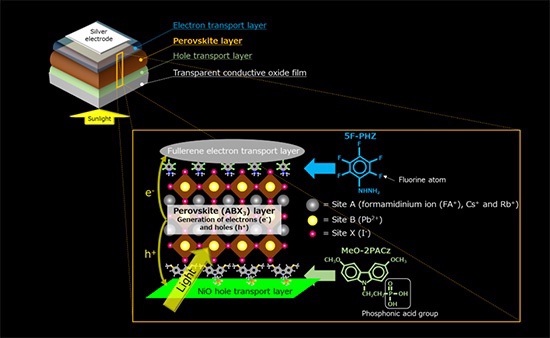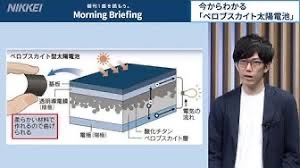

Perovskite battery: Continuous power generation over 1000h!
– NIMS Overcomes Durability and Power Generation Efficiency –
chinese media
science and technology daily
On October 11, 2022, a Japanese research group
We succeeded in developing a new perovskite solar cell that overcomes durability and power generation efficiency.
Japan National Institute for Materials Science (NIMS):
has an area of 1 square cm,
Maintains a photoelectric conversion efficiency of 20% or more under sunlight,
Continuous power generation for over 1000 hours
Developed perovskite solar cells.
Perovskite solar cell:
Perovskite solar cells are “easily and inexpensively manufactured,”
Expectations are high for next-generation solar cells.
on the other hand,
He explained that there was a problem with durability such as “it is easy to deteriorate when it reacts with water molecules”.
Battery developed this time:
At the interface between the perovskite layer and the electron transport layer,
Using a water-repellent hydrazine derivative (5F-PHZ),
It prevents contact with water molecules and improves durability.
in short,
At the interface between the hole transport layer and the perovskite layer,
A phosphonic acid derivative (MeO-2PACz) is used.
We have succeeded in preventing the formation of defects in the hole-transporting layer and increasing the power generation efficiency.
US Department of Energy
perovskite solar cell
The other day, research results of perovskite solar cells by US Department of Energy researchers
Published in the academic journal Nature.
Countries are entrusting the future of solar cells to this potential solar cell development.
chinese media
https://www.recordchina.co.jp/b902569-s25-c20-d0193.html
Batterie pérovskite : Génération d’énergie continue sur 1000h !
– NIMS surmonte la durabilité et l’efficacité de la production d’énergie –
médias chinois
science et technologie au quotidien
Le 11 octobre 2022, un groupe de recherche japonais
Nous avons réussi à développer une nouvelle cellule solaire en pérovskite qui surpasse la durabilité et l’efficacité de la production d’énergie.
Institut national japonais pour la science des matériaux (NIMS) :
a une superficie de 1 cm carré,
Maintient une efficacité de conversion photoélectrique de 20% ou plus sous la lumière du soleil,
Production d’énergie continue pendant plus de 1000 heures
Développement de cellules solaires en pérovskite.
Cellule solaire pérovskite :
Les cellules solaires en pérovskite sont «fabriquées facilement et à peu de frais»,
Les attentes sont élevées pour les cellules solaires de nouvelle génération.
d’autre part,
Il a expliqué qu’il y avait un problème de durabilité tel que “il est facile de se détériorer lorsqu’il réagit avec des molécules d’eau”.
Batterie développée cette fois :
A l’interface entre la couche de pérovskite et la couche de transport d’électrons,
Utilisation d’un dérivé d’hydrazine hydrofuge (5F-PHZ),
Il empêche le contact avec les molécules d’eau et améliore la durabilité.
bref,
A l’interface entre la couche de transport de trous et la couche de pérovskite,
Un dérivé d’acide phosphonique (MeO-2PACz) est utilisé.
Nous avons réussi à empêcher la formation de défauts dans la couche de transport de trous et à augmenter l’efficacité de la production d’énergie.
Département américain de l’énergie
cellule solaire pérovskite
L’autre jour, les résultats de la recherche sur les cellules solaires à pérovskite par des chercheurs du Département américain de l’énergie
Publié dans la revue académique Nature.
Les pays confient l’avenir des cellules solaires à ce développement potentiel de cellules solaires.
médias chinois
Perowskit-Akku: Kontinuierliche Stromerzeugung über 1000h!
– NIMS übertrifft Haltbarkeit und Effizienz der Stromerzeugung –
chinesische Medien
Wissenschaft und Technik täglich
Am 11. Oktober 2022 eine japanische Forschungsgruppe
Es ist uns gelungen, eine neue Perowskit-Solarzelle zu entwickeln, die Haltbarkeit und Effizienz der Stromerzeugung übertrifft.
Japanisches Nationales Institut für Materialwissenschaften (NIMS):
hat eine Fläche von 1 Quadratzentimeter,
Behält einen photoelektrischen Umwandlungswirkungsgrad von 20 % oder mehr unter Sonnenlicht bei,
Kontinuierliche Stromerzeugung für über 1000 Stunden
Entwickelte Perowskit-Solarzellen.
Perowskit-Solarzelle:
Perowskit-Solarzellen sind „einfach und kostengünstig herzustellen“
Die Erwartungen an Solarzellen der nächsten Generation sind hoch.
auf der anderen Seite,
Er erklärte, dass es ein Problem mit der Haltbarkeit gebe, wie z. B. „es kann sich leicht verschlechtern, wenn es mit Wassermolekülen reagiert“.
Akku diesmal entwickelt:
An der Grenzfläche zwischen der Perowskitschicht und der Elektronentransportschicht,
Verwendung eines wasserabweisenden Hydrazinderivats (5F-PHZ),
Es verhindert den Kontakt mit Wassermolekülen und verbessert die Haltbarkeit.
Zusamenfassend,
An der Grenzfläche zwischen der Lochtransportschicht und der Perowskitschicht,
Es wird ein Phosphonsäurederivat (MeO-2PACz) verwendet.
Es ist uns gelungen, die Bildung von Defekten in der Lochtransportschicht zu verhindern und die Leistungserzeugungseffizienz zu erhöhen.
US-Energieministerium
Perowskit-Solarzelle
Neulich Forschungsergebnisse von Perowskit-Solarzellen von Forschern des US-Energieministeriums
Veröffentlicht in der Fachzeitschrift Nature.
Länder vertrauen dieser potenziellen Solarzellenentwicklung die Zukunft der Solarzellen an.
chinesische Medien
Achieving Photovoltaic Power Generation for over 1,000 Continuous Hours at an Efficiency of More than 20%
NIMS
Abstract
NIMS has developed a durable 1-cm2 perovskite solar cell
capable of generating electricity for more than 1,000 continuous hours at a photoelectric conversion efficiency (i.e., power generation efficiency) of more than 20% in exposure to sunlight.
Because this solar cell can be fabricated on the surface of a plastic material at approximately 100°C,
this technique may be used to develop light, versatile solar cells.
Solar cells have been a vital component of decarbonization policies,
making them the subject of intense research around the globe.
Perovskite solar cells
are a potentially promising next-generation solar cell technology because they can be produced more easily and at lower cost than conventional solar cells.
However, perovskite solar cells also have disadvantages:
they are prone to degradation when they react with water molecules and it had proven difficult to make them both durable and highly efficient.
Most perovskite solar cells have similar power generation mechanisms.
When the perovskite layer absorbs sunlight, it generates electrons and holes.
These electrons and holes then
migrate separately into the adjacent electron transport layer and hole transport layer, respectively, where they flow to produce an electric current.
To simultaneously improve the efficiency and durability of perovskite solar cells,
these layers and the interfaces between them need to enable electrons and holes to move through them more freely while rendering the interfaces impermeable to water molecules.
https://www.nims.go.jp/eng/news/press/2022/09/202209160.html